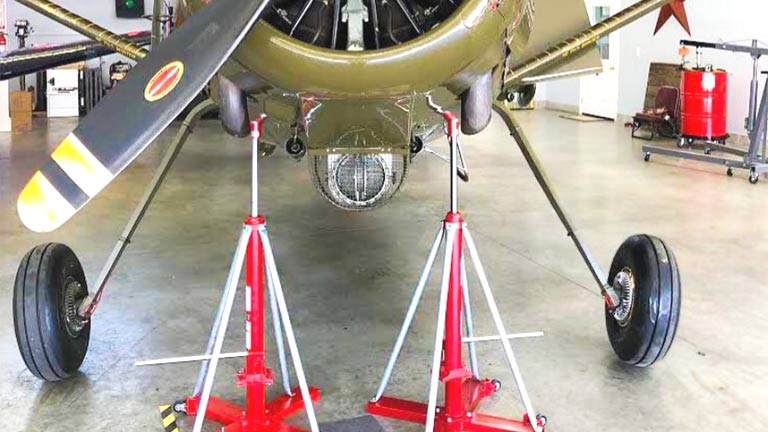When it comes to the sophisticated world of aircraft maintenance, the importance of specialized equipment cannot be overstated. Among the array of tools and machinery used in aircraft upkeep, airplane jacks stand out as essential equipment. These durable and adaptable tools are essential to maintaining the effectiveness and safety of maintenance processes for different kinds of aircraft. You shall examine the importance of airplane jacks, their varieties, and how they support the smooth operation of the aviation sector in this investigation.
The Backbone of Aircraft Maintenance
Airplane jacks serve as the backbone of aircraft maintenance, providing the necessary support for technicians to access critical components located beneath the aircraft. The hydraulic systems integrated into these jacks allow for precise control and adjustment, ensuring that the aircraft is lifted securely and uniformly. This capability is particularly crucial during routine inspections, repairs, or component replacements. Without the reliable support of these jacks, the maintenance process would become not only cumbersome but also hazardous. The use of airplane jacks enhances the overall safety and efficiency of maintenance procedures, reflecting their indispensable role in aviation.
Diverse Types for Varied Needs
The world of aviation is diverse, with an array of aircraft ranging from small private planes to large commercial jets. Recognizing this diversity, manufacturers have developed different types of airplane jacks to cater to varied needs. For smaller aircraft, scissor jacks may be sufficient, providing stability during maintenance tasks. On the other hand, larger and heavier aircraft may require hydraulic jacks with enhanced lifting capacities. These diverse types of jacks showcase the adaptability and versatility of the equipment, ensuring that every aircraft, regardless of its size or model, can receive the exacting maintenance it demands.
Ensuring Structural Integrity
A critical aspect of aircraft maintenance is ensuring the structural integrity of the aircraft. This involves inspecting and addressing any issues related to the aircraft’s framework, landing gear, or undercarriage. Airplane jacks play a pivotal role in this process by lifting the aircraft off the ground, allowing technicians to examine and repair structural components thoroughly. The precise control offered by hydraulic jacks ensures that the aircraft is raised evenly, preventing any stress on the structure. Thus, the use of airplane jacks becomes synonymous with upholding the structural integrity of an aircraft, contributing to its overall safety and longevity.
Facilitating Engine Maintenance
Beyond the aircraft’s structure, engines are at the heart of its functionality. Maintaining engines regularly is essential to guaranteeing both peak performance and flight safety. With their lifting capabilities, airplane jacks provide the necessary clearance for technicians to access and service the aircraft’s engines. This accessibility is invaluable for inspections, repairs, and even engine replacements. The ability to lift the aircraft precisely allows for a systematic approach to engine maintenance, underscoring the significance of airplane jacks in keeping aviation machinery in top-notch condition.
Mitigating Safety Risks
Safety is above all in the aviation industry, and the use of reliable equipment is instrumental in mitigating risks. Aircraft jacks contribute significantly to safety during maintenance procedures. The hydraulic systems and sturdy construction of these jacks ensure that the aircraft remains stable and secure while elevated. Maintaining this stability is essential to avoiding mishaps or accidents while performing maintenance. The painstaking design and engineering of airplane jacks align with the stringent safety standards of the aviation industry, providing a reliable foundation for technicians to carry out their work confidently.
Industry Compliance and Standards
In the world of aviation, adherence to industry regulations and standards is non-negotiable. Airplane jacks, as specific equipment, are subject to stringent compliance requirements to ensure their reliability and safety. Manufacturers must follow these guidelines while designing, producing, and testing the jacks. This commitment to compliance is essential for instilling confidence in aviation professionals who rely on the equipment for safe and effective maintenance. The adherence to industry standards reflects the dedication of aircraft jack manufacturers to prioritize quality and safety, ultimately contributing to the overall reliability of aviation maintenance processes.
Conclusion
The role of airplane jacks in the realm of aviation maintenance cannot be overstated. Serving as a pivotal point.
for safety, efficiency, and precision, these specific tools are indispensable for technicians working to keep aircraft in optimal condition. From facilitating routine inspections to supporting engine maintenance, airplane jacks contribute significantly to the longevity and reliability of aviation machinery. As the aviation industry continues to evolve, the importance of adhering to industry standards and leveraging cutting-edge technology in the design and production of airplane jacks remains paramount.


